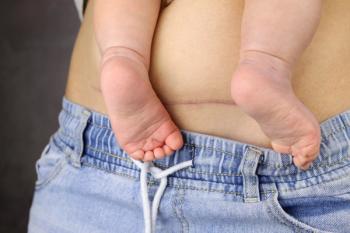
What today’s ob/gyn needs to know about Asherman’s syndrome
Minimizing intrauterine trauma is the key to prevention of adhesions, but treatment is possible when they occur.
Asherman’s syndrome, also known as intrauterine adhesions (IUA) and intrauterine synechiae, was first described in the late 19th century1,2 and further elucidated in two case series by Israeli physician Dr. Joseph G. Asherman as “amenorrhea trumatica.”3,4 Classically Asherman’s described complete obliteration of the uterine cavity by adhesive disease leading to amenorrhea; however, the term is now commonly applied to all patients whose adhesive disease process is symptomatic. Symptoms vary and can include hypomenorrhea or amenorrhea, infertility, recurrent pregnancy loss, and dysmenorrhea.
The true prevalence of intrauterine adhesions is unknown because invasive imaging studies or hysteroscopy such as saline infusion sonography (SIS), hysterosalpingogram (HSG), or hysteroscopy are required for diagnosis. These imaging studies are generally performed to evaluate patients that already have at least one symptom of Asherman’s syndrome. There are likely a significant proportion of additional patients with intrauterine adhesions who are asymptomatic or not concerned with their hypomenorrhea. Given these factors, the closest estimate of a baseline prevalence is approximately 1.5%, based on incidental HSG diagnosis.5 Once a previous uterine procedure is included in the query, disease prevalence rises sharply.
Risk factors
In general, most intrauterine adhesions are thought to be secondary to traumatic instrumentation of the uterus. While not all instrumentation leads to adhesion formation, certain factors increase risk. Women in the late peripartum and postpartum period are particularly at risk, and the elevated risk can last up to 4 weeks following either delivery or miscarriage,6 presumably related to a patient’s hypo-estrogenic state. A 2013 meta-analysis found that the pooled risk of intrauterine adhesions (IUA) was 19.1% in women with hysteroscopic evaluation within 1 year of miscarriage.7 Multiple miscarriages or procedures increase this risk.8 Additional risk factors include direct apposition of resected pathological tissue, such as in a hysteroscopic myomectomy with multiple fibroids, septum resection or metroplasty, and uterine compression sutures (Tables 1 and 2).9-11 Although rare in North America, tuberculosis is the only known infectious cause of IUAs. In a 1982 Israeli retrospective review, tuberculosis accounted for 4% of the Asherman’s cases.12 Currently, there is no evidence showing that either postpartum or chronic endometritis leads to Asherman’s syndrome.13 Generally, adhesions are formed when the fibrin matrix originally laid down during the first stage of wound healing is not appropriately removed. If normal fibrinolysis does not occur, scar tissue forms between two opposed surfaces. Uterine adhesions occur when the basalis layer of the endometrium or myometrium is damaged. The resulting adhesions can range from thin and filmy to dense and fibrotic. Loss of the basalis layer of the endometrium without formation of adhesive disease is referred to as “Unstuck Asherman’s” or endometrial sclerosis, and patients with it can present with many of the same symptoms. Asherman’s symptoms are caused by mechanical blockage of menstrual shedding, or decreased vascularity of the adhesive disease relative to normal endometrium.13
Diagnosis
The gold standard for diagnosis of IUA is hysteroscopy. SIS and/or HSG are often used in initial workup of patients with Asherman’s and they have high sensitivity but low specificity. Pelvic sonography without use of a distention media is of limited use, however, a very thin or interrupted endometrial stripe may suggest injury to the basalis layer. Lack of withdrawal bleeding following estrogen and progesterone challenges should trigger hysteroscopic evaluation in patients with an appropriate history. A pelvic exam should be performed in initial evaluation patients with symptoms, but it is generally of limited value for this diagnosis. We have found that in patients being evaluated for amenorrhea, a complaint of catamenial pain and/or thickened fundal stripe or hematometria on ultrasound tend to be associated with a better prognosis.
At least seven separate and distinct classification systems exist for IUAs,14 and the system proposed in 1978 by Marsh et al is probably best known.15 It classifies adhesions into three categories-minimal, moderate, and severe-based on hysteroscopic findings (Table 3). A widely used scientific classification set forth in 1998 by the American Fertility Society (now the American Society for Reproductive Medicine [ASRM]) includes sequela of adhesions as well as the extent of adhesions. It also allows for classification based on findings from HSG and hysteroscopy (Table 4).16 Currently, there is no single commonly agreed upon classification system, nor is there an existing recommendation for a unified system from AAGL, the International Federation of Gynecology and Obstetrics (FIGO), or the American College of Obstetricians and Gynecologists (ACOG).
Primary treatments
Hysteroscopic lysis of IUAs is the primary initial treatment in patients with Asherman’s syndrome who have symptoms. However, expectant management, particularly in the absence of symptoms, is a reasonable option. A single study demonstrated subsequent pregnancy in close to 50% and resumption of menses in more than three-quarters of women managed expectantly.12 There are no data to suggest a benefit from hormonal management alone in treatment of Asherman’s, but in patients who no longer desire fertility, progestational therapy can be used to suppress menses and decrease catamenial pain.
Prior to the advent of hysteroscopy, blind approaches were the standard of care. This included cervical probing and dilation and curettage. Outcomes were only slightly better than those in patients managed expectantly.12 These modalities are no longer recommended.14
Hysteroscopy allows for both diagnosis with classification, and treatment. The primary treatment of filmy adhesions can often be accomplished with blunt dissection using the diagnostic hysteroscope. For anything more than minimal, filmy adhesions, operative lysis should be performed. While hysteroscopic adhesiolysis has been described using radiofrequency needles or loops and the YAG laser, we strongly advocate use of cold scissors to avoid thermal injury to the endometrium and minimize recurrent scar formation (Table 5). Lysis can be performed under transabdominal ultrasound guidance if a patient has cervical adhesions or normal anatomic landmarks cannot be visualized.
In cases of complete cavitary obliteration, many techniques have been described, but there is no standard of care. In general, these techniques involve creation of a neo-cavity under visual guidance by either fluoroscopy or sonography. We recommend priming the patient with a course of estrogen to better delineate any remaining portions of endometrium and then performing dissection under ultrasound guidance. In our opinion, there is no role for laparotomy or laparoscopy in initial treatment of Asherman’s.
Secondary prevention
Primary hysteroscopic adhesiolysis typically leads to some level of adhesion reformation. Strategies for secondary prevention are of the utmost importance in any treatment plan and numerous approaches are well described. The theoretical and intuitive benefit of estrogen for endometrial proliferation and healing has led to near universal use of supplementation with the hormone following initial treatment. However, there are no published trials specifically comparing estrogen supplementation to expectant management after initial surgery. A meta-analysis of studies that included estrogen for secondary prevention showed no harm and suggested some benefit, but there is no high-quality evidence to strongly support estrogen use.17 There is also no consensus on type, dosage, or duration of estrogen treatment following primary surgical management. A meta-analysis looking at pooled results of post-adhesiolysis treatments suggests that estrogen use after initial treatment may be beneficial and does not appear harmful.17 We therefore continue to advocate for unopposed estrogen for a period of time following treatment when not contraindicated.
Stents
Stents of many types have been used in an effort to prevent reformation of scar tissue across the endometrial cavity following primary treatment. These include solid barriers such as intrauterine devices (IUDs), Foley catheters, Cook Balloon Uterine Stents, and amnion graft or gel matrix such as hyaluronic acid.
IUDs have historically been used as a mechanical barrier between the walls of the uterus following hysteroscopic adhesiolysis, but they have fallen out of favor because of difficulty obtaining an inert IUD. Both the pro-inflammatory copper IUD and endometrial-suppressing levonorgestrel-eluting intrauterine system are poorly suited to endometrial recovery.
Currently, the most commonly used stent is an inflated pediatric Foley catheter or Cook Balloon Uterine Stent. This is generally left in place for 3 to 14 days. A nonrandomized trial comparing the Foley catheter to an IUD favored the Foley catheter.18 Studies also suggest low risk of infection with the Foley catheter.19 A randomized study including use of an amnion graft in addition to the Foley catheter demonstrated decreased adhesions at interval hysteroscopy when using the graft.20 Ongoing research looking into additional uses of stem cells in treatment of recurrent IUAs shows promise, but this therapy is still investigational.
Hyaluronic acid gel has been studied as an adjunct to surgery. A 2003 randomized controlled study showed decreased IUA formation following placement of the gel, compared with no treatment.21 In a more recent retrospective cohort study looking at different stenting options, no difference was found between the control group and the hyaluronic acid group.20 Of note, this study did find stenting with the Foley catheter to be superior to both no treatment and the other stents evaluated.
Serial adhesiolysis
Regardless of the prevention method employed, between one-third and two-thirds of patients will form subsequent adhesions.14 Evaluation of the endometrial cavity should be performed after the initial surgery and is commonly done with either HSG or repeat hysteroscopy. Repeating hysteroscopy at 2- to 3-week intervals can interrupt adhesion reformation and permits easy management of forming adhesions. This treatment can be continued until no further adhesion reformation is observed. In a series of patients in whom this approach was used, the mean and median number of follow-up hysteroscopies was three and menstrual and fertility outcomes were comparable to other approaches involving use of a stent.22
Office vs. OR
In general, IUA have low vascularity and innervation, which makes these cases ideal for an office-based approach. One study found that 87.6% of patients tolerated office hysteroscopy.23 Given the high likelihood of adhesion reformation following the initial adhesiolysis, serial procedures are warranted. Using an office-based approach to these procedures minimizes cost and maximizes patient convenience. In postpartum patients who develop intrauterine scarring, the expectation of amenorrhea generally leads to delayed recognition of disease, compounding the emotional trauma of the antecedent uterine injury. We find the less intrusive and transparent nature of an office-based approach to be emotionally therapeutic.
Our practice
After taking a detailed history and performing a physical, if Asherman’s is suspected, we typically schedule the patient for an office-based hysteroscopy. Occasionally we move directly to the operating room if the patient has reported a severe intolerance of an HSG/SIS or does not tolerate the office pelvic examination. We attempt to time the hysteroscopy for the early proliferative phase of the patient’s menstrual cycle or use progestational therapy to optimize visualization in menstruating patients.
Patients are advised to take a high-dose nonsteroidal anti-inflammatory drug 1 hour prior to the procedure. A 3- to 5-mm rigid hysteroscope with a 5 French working channel is used, allowing for use of cold semi-rigid scissors. For endometrial access, we use vaginoscopy (Table 6), as it is better tolerated than a speculum and tenaculum. Dilation is rarely required so paracervical blocks are of little benefit. For distention we use a 1- to 3-L pressure bag of normal saline, cystoscopy tubing, and passive out flow into an under-buttocks drape. Procedures typically last 2 to 20 minutes and are well tolerated. Adhesiolysis is performed bluntly or with the scissors. When the scissors are used, we move from filmy adhesions and windows to dense adhesions, which are lysed in the midline. Small pockets can be gently dilated using the hysteroscope or closed scissors. When possible, the tubal ostia are used as landmarks to establish the normal cavity size and shape. We typically use transabdominal sonography in amenorrheic patients in whom we anticipate cervical scarring and/or severe intrauterine scarring.
After significant adhesiolysis, we prescribe daily oral estradiol (2 mg po bid), unless it is otherwise contraindicated. The drug usually is continued through completion of the patient’s treatment. We do not use a post-procedure stent, mostly secondary to patient discomfort and the theoretical risk of infection, but we think it is a reasonable option. In our practice, we always perform a repeat hysteroscopic examination, and counsel patients that multiple/serial procedures are often necessary. We continue subsequent hysteroscopic resections at
2- to 3-week intervals, until a normal cavity is maintained. If estradiol is used, it is discontinued following the final procedure. We do not use antibiotics routinely at any point in the management process.
Primary and early prevention
Given that we know what procedures and factors place patients at greatest risk for subsequent formation of IUA and their sequela, we as ob/gyns should start thinking about primary prevention. When performing uterine procedures, particularly on postpartum patients, we recommend modifying surgical technique to minimize intrauterine trauma. This includes avoiding blind whole-cavity sharp curettage when targeted hysteroscopic resection is possible.
Recent data have shown some benefit for placement of hyaluronic acid gel following suction D&C.31 We also strongly recommend follow-up office hysteroscopy after procedures associated with risk of adhesion formation. These include: larger hysteroscopic myomectomies, in particular those with multiple fibroids resected; laparoscopic or open myomectomies where fibroids abutted or entered the cavity; and hysteroscopic septum resections. Finally, we also recommend that our obstetric colleagues discuss risk of IUA with patients who had peripartum D&Cs and recommend hysteroscopic evaluation after 6 weeks for vaginal delivery and 3 months for cesarean delivery, once adhesions have had time to form, but can still be relatively easily corrected.
Newsletter
Get the latest clinical updates, case studies, and expert commentary in obstetric and gynecologic care. Sign up now to stay informed.




















